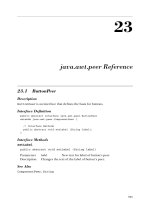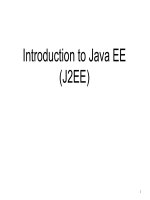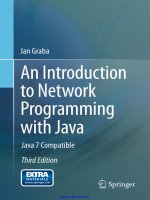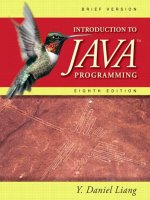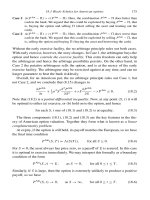An introduction to java programming 3 pdf
Bạn đang xem bản rút gọn của tài liệu. Xem và tải ngay bản đầy đủ của tài liệu tại đây (3.29 MB, 101 trang )
Download free eBooks at bookboon.com
2
David Etheridge
Java: Graphical User Interfaces
– An Introduction to Java Programming
Download free eBooks at bookboon.com
3
Java: Graphical User Interfaces – An Introduction to Java Programming
© 2009 David Etheridge & Ventus Publishing ApS
ISBN 978-87-7681-496-0
Download free eBooks at bookboon.com
Please click the advert
Java: Graphical User Interfaces
4
Contents
Contents
1. The Input/Output Package
1.1 An Introduction to Streams
1.2 Categories of Streams and their Classes
1.3 Using Streams
1.4 Object Streams
1.5 Files and File I/O
1.6 Data Streams
1.7 Summary of Streams
2. Collecting Data II
2.1 The Java Collections Framework
2.2 The Core Collection Interfaces
2.3 Implementation Types
2.4 Operations, Methods, Iterators and Algorithms
2.5 Generics and the Collections Framework
2.6 Collections in the Themed Application
2.7 Summary of the Java Collections Framework
6
7
7
11
19
21
25
27
28
28
28
31
34
36
42
46
Designed for high-achieving graduates across all disciplines, London Business School’s Masters
in Management provides specific and tangible foundations for a successful career in business.
This 12-month, full-time programme is a business qualification with impact. In 2010, our MiM
employment rate was 95% within 3 months of graduation*; the majority of graduates choosing to
work in consulting or financial services.
As well as a renowned qualification from a world-class business school, you also gain access
to the School’s network of more than 34,000 global alumni – a community that offers support and
opportunities throughout your career.
For more information visit
www.london.edu/mm, email or
give us a call on
+44 (0)20 7000 7573.
Masters in Management
The next step for
top-performing
graduates
* Figures taken from London Business School’s Masters in Management 2010 employment report
Download free eBooks at bookboon.com
Please click the advert
Java: Graphical User Interfaces
5
Contents
3. User Interfaces
3.1 What is a User Interface?
3.2 Client/Server Applications
3.3 The Construction of User Interfaces
3.4 A Visual Approach to GUI Design
3.5 Activating User Interface Components
3.6 The GUI for the Themed Application
3.7 Summary of Event Handling
4. Concurrency with Threads
4.1 An Introduction to Threads
4.2 Creating Threads
4.3 Using Threads in Java Applications
4.4 Summary of Threads
47
47
49
50
64
68
83
87
90
90
91
93
100
EADS unites a leading aircraft manufacturer, the world’s largest
helicopter supplier, a global leader in space programmes and a
worldwide leader in global security solutions and systems to form
Europe’s largest defence and aerospace group. More than
140,000 people work at Airbus, Astrium, Cassidian and Eurocopter,
in 90 locations globally, to deliver some of the industry’s most
exciting projects.
An EADS internship offers the chance to use your theoretical
knowledge and apply it first-hand to real situations and assignments
during your studies. Given a high level of responsibility, plenty of
learning and development opportunities, and all the support you need,
you will tackle interesting challenges on state-of-the-art products.
We take more than 5,000 interns every year across disciplines
ranging from engineering, IT, procurement and finance, to
strategy, customer support, marketing and sales. Positions are
available in France, Germany, Spain and the UK.
To find out more and apply, visit www.jobs.eads.com. You can also
find out more on our EADS Careers Facebook page.
Join EADS. A global leader in aerospace, defence and related services.
Let your imagination take shape.
Download free eBooks at bookboon.com
Please click the advert
Java: Graphical User Interfaces
6
The Input/Output Package
1. The Input/Output Package
Chapter One considers some of the classes of the java.io package. Java defines input and output (I/O) in
terms of classes known as streams. Streams provide system input and output in a way that isolates the
developer from the details about how an operating system provides access to system resources for the
purposes of I/O. Streams are not required for input and output when a graphical user interface (GUI) is
used to capture and display information in an application. Graphical user interface design is examined in
Chapter Three.
There are approximately 60 classes in the
java.io package. Consequently, this guide does not aim to cover
every stream class. Instead, some of the main categories of streams are explained in general terms and
examples are provided of the use of specific types of streams in a practical situation.
The reader is referred to the
java.io package of the API for the documentation associated with the many
stream classes provided by the Java language.
“The perfect start
of a successful,
international career.”
CLICK HERE
to discover why both socially
and academically the University
of Groningen is one of the best
places for a student to be
www.rug.nl/feb/education
Excellent Economics and Business programmes at:
Download free eBooks at bookboon.com
Java: Graphical User Interfaces
7
The Input/Output Package
1.1 An Introduction to Steams
A stream is an abstraction of the underlying mechanism that is used by an operating system to transfer
information into and out of a Java programme. The level of abstraction means that the developer uses
classes of the
java.io package for I/O. As a consequence, I/O can be regarded as a high-level programming
activity that transparently maps onto the low-level mechanisms associated with system I/O.
A stream is a sequence of bits of information that is passed along a virtual path between a source and a
destination. An input stream provides a path from a source to a programme and, similarly, an output
stream is a path from a programme to a destination. Figure 1.1 visualises the general representation of
streams as paths between code and a source or a destination.
Figure 1.1 The source and destination associated with a stream
Sources and destinations of information include files, disks and networked resources; the information
passed along streams can take any form, such as objects, text, images and sound.
1.2 Categories of Streams and their Classes
Streams in the
java.io package usually occur as input/output pairs and fall into one of three categories -
byte streams, character streams or object streams. This section looks at classes in the first of these two
categories in relatively general terms to give a flavour of their functionality and to encourage the reader to
refer to the API for the
java.io package. A later section examines object streams.
1.1.1 Byte Streams
A byte streams carries a sequence of binary data and is one of two types, either an input stream or an
output stream. To read a byte stream in an application, one of the subclasses of the
InputStream class is
used. An extract from the API displayed on the next page shows some of the input stream classes that are
subclasses of the abstract class
InputStream.
Download free eBooks at bookboon.com
Java: Graphical User Interfaces
8
The Input/Output Package
java.io
Class InputStream
java.lang.Object
java.io.InputStream
All Implemented Interfaces:
Closeable
Direct Known Subclasses:
AudioInputStream, ByteArrayInputStream, FileInputStream, FilterInputStream,
ObjectInputStream
Table 1.1 below summarises the main functions of these InputStream types, as indicated by the
documentation for each class in the API.
Type Function
AudioInputStream Reads a specified audio format and length of audio file
ByteArrayInputStream Contains in internal buffer that contains bytes read from the stream
FileInputStream Inputs bytes from a file in a file system
FilterInputSteam: has a number of
subclasses
Contains some other input stream, which it uses as its basic source
of data, possibly transforming the data along the way or providing
additional functionality
ObjectInputStream Reads primitive data and objects previously written using an
ObjectOutputStream
Table 1.1 Some of the input streams
Some of the corresponding output stream classes that are subclasses of the abstract class OutputStream
are shown in the next extract from the API.
java.io
Class OutputStream
java.lang.Object
java.io.OutputStream
All Implemented Interfaces:
Closeable
, Flushable
Direct Known Subclasses:
ByteArrayOutputStream, FileOutputStream, FilterOutputStream, ObjectOutputStream
Download free eBooks at bookboon.com
Please click the advert
Java: Graphical User Interfaces
9
The Input/Output Package
Table 1.2 below summarises the main function of these OutputStream types, as indicated by the
documentation for each class in the API.
Type Function
ByteArrayOutputStream Data is written into a byte array
FileOutputStream Writes data to a file
FilterOutputStream: has a number of
subclasses
Contains some other output stream, which it uses as its basic source
of data, possibly transforming the data along the way or providing
additional functionality
ObjectOutputStream Writes objects to a file for persistent storage
Table 1.2 Some of the output streams
The next sub-section presents a similar overview of some of the character streams.
1.2.2 Character Streams
The Java language uses the UTF–16 (Unified Transformation Format) 16 bit encoding to represent text
characters. The streams that carry text-based information are called readers and writers. To read a
character stream in an application, one of the subclasses of the Reader class is used. The following extract
from the API shows some of the readers that are subclasses of the abstract class
Reader.
© Agilent Technologies, Inc. 2012 u.s. 1-800-829-4444 canada: 1-877-894-4414
Teach with the Best.
Learn with the Best.
Agilent offers a wide variety of
affordable, industry-leading
electronic test equipment as well
as knowledge-rich, on-line resources
—for professors and students.
We have 100’s of comprehensive
web-based teaching tools,
lab experiments, application
notes, brochures, DVDs/
CDs, posters, and more.
See what Agilent can do for you.
www.agilent.com/find/EDUstudents
www.agilent.com/find/EDUeducators
Download free eBooks at bookboon.com
Java: Graphical User Interfaces
10
The Input/Output Package
java.io
Class Reader
java.lang.Object
java.io.Reader
All Implemented Interfaces:
Closeable
, Readable
Direct Known Subclasses:
BufferedReader
, CharArrayReader, InputStreamReader, StringReader
Table 1.3 summarises the main function of these readers, as indicated by the API.
Type Function
BufferedReader Reads text from a character-input stream, buffering characters so as
to provide for the efficient reading of characters, arrays, and lines
CharArrayReader This class implements a character buffer that can be used as a
character input stream
InputStreamReader An InputStreamReader is a bridge from byte streams to character
streams. It reads bytes and decodes them into characters using a
specified charset. The charset that it uses may be specified by name
or may be given explicitly, or the platform's default charset may be
accepted
StringReader A character stream whose source is a string
Table 1.3 Some of the readers
Some of the corresponding subclasses of the abstract class Writer are shown in the next extract from
the API.
java.io
Class Writer
java.lang.Object
java.io.Writer
All Implemented Interfaces:
Closeable
, Flushable, Appendable
Direct Known Subclasses:
BufferedWriter
, CharArrayWriter, OutputStreamWriter, PrintWriter, StringWriter
Table 1.4 on the next page summarises the main function of these writers, as indicated by the API.
Download free eBooks at bookboon.com
Java: Graphical User Interfaces
11
The Input/Output Package
Type Function
BufferedWriter Writes text to a character-output stream, buffering characters so as
to provide for the efficient writing of single characters, arrays, and
strings
CharArrayWriter This class implements a character buffer that can be used as a
character output stream
OutputStreamWriter An OutputStreamWriter is a bridge from character streams to byte
streams: Characters written to it are encoded into bytes using a
specified charset. The charset that it uses may be specified by
name or may be given explicitly, or the platform's default charset
may be accepted
PrintWriter Prints formatted representations of objects to a text output stream
StringWriter A character stream that collects its output in a string buffer, which
can then be used to construct a string
Table 1.4 Some of the writers
The next section gives some examples of using streams.
1.3 Using Streams
Although most applications use a GUI to input relatively small amounts of information to an application,
streams are very useful for testing the methods of classes in an application before such an interface is
constructed. On the output side of an application, object streams can be used to write objects out to a file
so that the data associated with an application takes on a persistent state. Streams are also extremely useful
when an application needs to output information to data storage devices or input data from them.
A general algorithm for using streams for I/O in an application can be expressed as follows:
1. Instantiate a stream object: this automatically opens the stream.
2. Read from or write to the stream in a try block.
3. Catch IOException objects (and any other exceptions that may
occur).
4. Close the stream.
An application typically uses more than one stream chained together, depending on whether a buffer or a
bridge or some other functionality is required: see tables 13.1 to 13.4 for a summary of the functionality of
streams. Chaining streams can be visualised as connecting pipes together, as you would do when
undertaking plumbing jobs at home, as shown in Figure 1.2. (The author strongly recommends that the
reader never attempt this kind of thing in your own home; instead, bring in a professional plumber to do
the work.)
Download free eBooks at bookboon.com
Please click the advert
Java: Graphical User Interfaces
12
The Input/Output Package
Figure 1.2 Chaining streams together
Chaining is achieved by passing a stream object into the constructor of another stream object, as will be
shown by the examples that are presented in sub-section 1.3.2 below. Before embarking on the examples
of chaining streams, sub-section 1.3.1 looks at how streams are used for screen output.
1.3.1 Screen Output
A number of examples in previous chapters use the statement
System.out.println( <parameter> );
to output the results of test classes to a computer’s screen.
Get Help Now
Go to www.helpmyassignment.co.uk for more info
Need help with your
dissertation?
Get in-depth feedback & advice from experts in your
topic area. Find out what you can do to improve
the quality of your dissertation!
Download free eBooks at bookboon.com
Java: Graphical User Interfaces
13
The Input/Output Package
The System class includes a number of fields that are used for input and output. The static field with the
identifier
out provides an output stream of the PrintStream type. The stream is automatically open and is
ready to accept output data.
The class
PrintStream inherits from a subclass of OutputStream, as shown in the extract from the API.
java.io
Class PrintStream
java.lang.Object
java.io.OutputStream
java.io.FilterOutputStream
java.io.PrintStream
A PrintStream object adds functionality to its parent output stream, so that it can print primitive data to
the console. All characters printed by a
PrintSteam object are converted into bytes using the platform's
default character encoding. One interesting and convenient feature of
PrintStream objects is that they
never throw an
IOException.
Standalone Java applications, such as those that use a dedicated
main method for testing purposes, write a
line of output as follows:
System.out.println( data );
The
print and println methods of the PrintStream class are overloaded for primitive data types.
If an object reference is passed to any of the variants of
print or println, as in
System.out.println( objectReference );
the
println method calls String.valueOf( objectReference ) to return the object’s String value before it
behaves as though it invokes
println with a String passed to it. In effect, the statement behaves as if it
invokes the
toString method on objectReference.
In general, invoking
toString on an object reference returns what is known as the String representation of
the object. It is good practice to override this method for all developer-written classes so that the result is a
representation of the object that is informative when invoked.
1.3.2 Keyboard Input
The static field with the identifier
in of the System class is an InputStream object that can be used for
keyboard input. Given that
InputStream is an abstract class, an appropriate subclass is automatically
instantiated when accessing the
in field of System. This stream is already open and ready to supply input
data. The
InputStream class has a read method that reads a byte of data and returns an int in the range 0
to 255. The
int is cast to convert it to a char.
The example that follows shows how a byte is entered via the computer’s keyboard and output to the
computer’s screen.
Download free eBooks at bookboon.com
Java: Graphical User Interfaces
14
The Input/Output Package
import java.io.*;
public class Keyboard {
public static void main( String[ ] args ) {
try
{
System.out.print( "Please press any key: " );
char key = ( char )System.in.read( );
System.out.print( "The key pressed was: " + key );
System.out.println( "The class is: " + System.in.toString( ) );
}
catch( IOException ioe )
{
// do something about the exception
}
} // end of main
} // end of class definition
Executing main results in the following output:
C:\ > java Keyboard
Please press any key: a
The key pressed was: a
The class is: java.io.BufferedInputStream@3e25a5
The output shows that selecting
System.in.toString( ) returns the object reference of the object that is
automatically instantiated when referring to
System.in and shows that the object is of the type
BufferedInputStream. The class BufferedInputStream is shown in the next extract from the API.
java.io
Class BufferedInputStream
java.lang.Object
java.io.InputStream
java.io.FilterInputStream
java.io.BufferedInputStream
We can conclude, therefore, that selecting System.in instantiates an object of the BufferedInputStream
type and closes the stream when it has been finished with.
The code for the
Keyboard class (on the previous page) implies that invoking read should be included in a
loop to add each
char to a String to, in effect, input a string of characters via the keyboard. However, the
code would have to detect when the last character has been entered in order to determine the end of
the loop.
Download free eBooks at bookboon.com
Please click the advert
Java: Graphical User Interfaces
15
The Input/Output Package
In short, using System.in.read is not a particularly useful way to input data from the computer’s keyboard.
As an alternative, a number of streams can be chained together in order to read characters and strings and
numbers from the keyboard.
String Input via the Keyboard
The following class chains three streams in order to read characters from the keyboard. Firstly,
System.in
is the byte stream that is used for keyboard input, as shown in the previous sub-section. Secondly,
System.in is connected to a stream of the InputStreamReader type to act a bridge between the byte stream
and a character stream. Thirdly, a buffer is required because keyboard input tends to be irregular.
Therefore, the
InputStreamReader is connected to a buffer of the BufferedReader type. The readLine
method of BufferedReader reads, in the example below, a set of characters from the keyboard. When the
enter key is pressed, the method returns a
String.
Chaining the three streams together is achieved by passing one stream object to the constructor of the next
stream in the chain, as shown in the class definition that follows and continues on the next page.
Free online Magazines
Click here to download
SpeakMagazines.com
Download free eBooks at bookboon.com
Java: Graphical User Interfaces
16
The Input/Output Package
import java.io.*;
public class KeyboardInput {
public static void main( String[ ] args ) {
// Instantiate a bridge stream and pass the object instantiated by
System.in to
// its constructor.
InputStreamReader isr = new InputStreamReader( System.in );
// Instantiate a buffered stream and pass the
InputStreamReader to its
// constructor.
BufferedReader kbd = new BufferedReader( isr );
try
{
System.out.print( "Enter some characters and press “ +
“return when finished: " );
String s = kbd.readLine( );
System.out.println( "The String was: " + s );
// Close the initial stream; this will close all streams connected to it.
kbd.close( );
}
catch( IOException e )
{
e.printStackTrace( );
}
} // end of main
} // end of class definition
The result of executing main is:
Enter some characters and press return when finished: Hello World
The String was: Hello World
Numerical Input via the Keyboard
System.in cannot be expected to distinguish numerical input from pressing any other of the keys on the
keyboard. The object instantiated by
System.in reads the next byte of data entered via the keyboard when
its
read method is invoked. When this object is chained, as in the code for KeyboardInput in the previous
sub-section, the
readLine method of a BufferedReader returns a String.
Numerical input via the keyboard is relatively straightforward in that a
String is returned in a similar way
to that used in the code for the KeyboardInput class. The
String is then converted into the corresponding
primitive type.
The class definition shown on the next page illustrates this technique for integer input.
Download free eBooks at bookboon.com
Java: Graphical User Interfaces
17
The Input/Output Package
import java.io.*;
public class ReadInt {
public static void main( String[ ] args ) {
try
{
BufferedReader kbd = new BufferedReader( new
InputStreamReader( System.in ) );
System.out.print( "Enter an integer: " );
String intStr = kbd.readLine( );
// Convert the String into its corresponding integer by calling one of
// the methods of the
Integer wrapper class.
int number = Integer.parseInt( intStr );
System.out.println( "The number is " + number );
}
catch( IOException ioe )
{
// do something about it
}
} //End of main.
} // End of class definition.
The result of executing main is as follows:
Enter an integer: 123
The number is 123
The class definition shown on the next page shows a similar way to enter a double into a programme from
the keyboard.
Download free eBooks at bookboon.com
Please click the advert
Java: Graphical User Interfaces
18
The Input/Output Package
import java.io.*;
public class ReadDouble {
public static void main( String[ ] args ) {
try
{
BufferedReader kbd = new BufferedReader(
new InputStreamReader( System.in ) );
System.out.print( "Enter a double: " );
String dblStr = kbd.readLine( );
// The next two statements convert the String to a double.
Double dblObj = Double.valueOf( dblStr );
double number = dblObj.doubleValue( );
System.out.println( "The number is " + number );
}
catch ( IOException ioe )
{
// do something about it
}
} // end of main
} // end of ReadDouble
© UBS 2010. All rights reserved.
www.ubs.com/graduates
Looking for a career where your ideas could really make a difference? UBS’s
Graduate Programme and internships are a chance for you to experience
for yourself what it’s like to be part of a global team that rewards your input
and believes in succeeding together.
Wherever you are in your academic career, make your future a part of ours
by visiting www.ubs.com/graduates.
You’re full of
energy
and ideas
. And that’s
just what we are looking for.
Download free eBooks at bookboon.com
Java: Graphical User Interfaces
19
The Input/Output Package
As the examples show, it takes several lines of code to input primitive data values via the keyboard.
Fortunately, there are a number of classes in the public domain that make this task easier than that shown
in the examples above. One such class is
EasyInput written by David J. Barnes. Non-static methods of the
EasyInput class carry out the required steps to enter primitive data values from the keyboard. For example,
the
nextInt method of EasyInput returns an int value as follows.
// Instantiate an
EasyInput object.
EasyInput kbd = new EasyInput( );
int intEnteredAtTheKeyboard = kbd.nextInt( );
That is all there is to it!
EasyInput can be downloaded from:
1.4 Object Streams
Section 1.2 mentions a third category of streams: object streams. Object streams are typically used in an
application when live objects are required to be written to a byte stream and either saved to a local file or
transferred across a network to a remote host. An
OutputObjectStream object writes such an object to a
stream and an InputObjectStream object reconstitutes the object from the stream.
The process of translating an object into a stream of bytes is known as serialization, where it is important
to use the American spelling (for reasons that will be explained in the next paragraph); the reverse process
of reconstituting an object from an input stream is known as deserialization. The term ‘serialization’ is
usually used to describe the overall process of serialization and deserialization.
To enable an object to be serialized, it must implement the interface
java.io.Serializable (spelt with a ‘z’).
The
java.io.Serializable interface is a type of interface known as a tagged interface. A tagged interface,
such as the
java.io.Serializable interface, does not declare any members. When java.io.Serializable is
implemented, its purpose is to alert the JVM that an object is serializable. Serializing an object to a file
saves the object’s state and deserializing the same object reconstitutes its saved state.
An interesting and vitally useful feature of object serialization is that when an object is serialized, an
object graph is actually serialized. Writing an object graph to an object stream means that all objects
referenced by the object being written to the stream are also written to the stream, as long as their class
definitions include the clause to implement the
java.io.Serializable interface.
The next sub-section discusses an example, taken from the themed application, to illustrate how
serialization is used to maintain persistent data in the Media Store application.
Download free eBooks at bookboon.com
Java: Graphical User Interfaces
20
The Input/Output Package
1.4.1 Using Object Streams in the Themed Application
When a member joins the Media Store, the new member is provided with a (virtual) membership card that
is used to record the details about each DVD that the member takes on loan from the store. The object
references of new members are added to an array that is used to store the object references of all members
of the Media Store. Therefore, the array that stores the object reference to each member also stores an
object graph for each
Member object. In the context of the themed application, the object graph for a
Member object includes references to the member’s DvdMembershipCard object which, in turn, includes
references to each
Dvd object associated with the card. The classes DvdMembershipCard, Dvd and Member
implement java.io.Serializable.
The object that represents the Media Store of the type
MediaStore includes a method for writing out the
array of members to a binary .dat file, as shown next.
/**
* This method writes the array of members to a .dat file.
*/
public void writeMembers( ) {
try
{
// Create a stream to write data to a file. The String is the path to the .dat file.
FileOutputStream fos = new
FileOutputStream("C:\\Temp\\members.dat");
// Connect an object stream to the file stream.
ObjectOutputStream oos = new ObjectOutputStream( fos );
// Write the array of members to the object stream;
getMembers returns the
// array of members.
oos.writeObject( getMembers( ) );
// Release resources.
oos.flush( );
oos.close( );
fos.close( );
}
catch ( IOException ioe )
{
System.out.println( "Error: " + ioe.getMessage( ) );
}
} // End of writeMembers.
The method is called after each card transaction so that the application’s data is persistent.
The corresponding method that reads the array of members into the application is shown on the next page.
Download free eBooks at bookboon.com
Java: Graphical User Interfaces
21
The Input/Output Package
/**
* This method reads the .dat file of members.
*/
public void readMembers( ) {
try
{
// The String is the path to the .dat file.
FileInputStream fis = new FileInputStream( "C://Temp//members.dat" );
// Connect an object stream to the file stream.
ObjectInputStream ois = new ObjectInputStream( fis );
// Note the cast in the next statement;
members is a variable of the Member [ ]
// type.
members = ( Member [ ] )ois.readObject( );
// Release resources.
ois.flush( );
ois.close( );
fis.close( );
}
catch ( IOException ioe )
{
System.out.println( "Error: " + ioe.getMessage( ) );
}
} // End of readMembers.
The best that the compiler can promise is to return an object of the
Object class when the readObject
method of the ObjectInputStream class is invoked; it does not know – at compile time – what type of
object is read from the stream. Hence there is a cast in the statement that invokes
readObject.
Judicious use of the pair of methods
writeMembers and readMembers serializes the object graph
associated with the array of
Member objects and provides a persistent data layer in the themed application.
Thus, data about members is stored externally to the application to a .dat file on (the author’s) C: drive.
1.5 Files and File I/O
File objects and file streams are useful when an application needs to write data to a file and read data from
a file, where the file (or files) are used for persistent data associated with the application.
The activities associated with files and file I/O involves the following tasks: creating file objects; using
utilities for file objects; reading and writing with file streams.
1.5.1 Creating File Objects
An instance of the
File class is an abstract representation of the path name of a file and may or may
not represent an existing file. For example, the following class definition compiles whether the file
exists or not.
Download free eBooks at bookboon.com
Please click the advert
Java: Graphical User Interfaces
22
The Input/Output Package
import java.io.File;
public class Files {
public static void main( String[ ] args ) {
File myFile = new File( "C:\\myfile.txt" );
} // end of main
} // end of class definition
If the file does not exist at the path specified and if the file object with the reference
myFile is selected in
subsequent code, a
FileNotFoundException is thrown.
1.5.2 File Tests and Utilities
If the file does exist, there are several tests and utilities that are available as methods of the
File class. The
class that follows illustrates some of these tests and utilities:
try … catch blocks are omitted for the sake
of brevity.
360°
thinking
.
© Deloitte & Touche LLP and affiliated entities.
Discover the truth at www.deloitte.ca/careers
Download free eBooks at bookboon.com
Java: Graphical User Interfaces
23
The Input/Output Package
import java.io.File;
public class Files {
public static void main( String[ ] args ) {
File myFile = new File( "C:\\myfile.txt" );
System.out.println( myFile.getName( ) );
System.out.println( myFile.getPath( ) );
System.out.println( myFile.exists( ) );
} // end of main
} // end of class definition
The result of executing
main is.
myfile.txt
C:\myfile.txt
true
1.5.3 Reading and Writing with File Steam Classes
The
File streams - FileInputStream and FileOutputStream – and File readers/writers – FileReader and
FileWriter – are used to read from and write to a file.
A
FileReader object can be used to read character streams, as illustrated by the following code. A
BufferedReader object is connected to the FileReader object used so that its readLine method can
be invoked.
import java.io.*;
public class FileRead {
public static void main( String[ ] args ) {
BufferedReader br = new BufferedReader (
new FileReader( "c:\\myfile.txt" ) );
String inStr = br.readLine( );
System.out.println( "The contents of the file are: " + inStr );
} // end of main
} // end of class definition
Executing
main displays the contents of the existing file named myfile.txt, as follows:
The contents of the file are: Hello World
Similarly a
FileInputStream object can be used to read a byte stream, as illustrated by the code that
follows on the next page.
Download free eBooks at bookboon.com
Java: Graphical User Interfaces
24
The Input/Output Package
import java.io.*;
public class FileRead {
public static void main( String[ ] args ) throws IOException {
FileInputStream fis = new FileInputStream( "c:\\myfile.txt" );
InputStreamReader isr = new InputStreamReader( fis );
BufferedReader kbd = new BufferedReader( isr );
String s = kbd.readLine( );
System.out.println( "The contents of the file are: " + s );
} // end of main
} // end of class definition
Executing
main displays the contents of the same file named myfile.txt, as follows:
The contents of the file are: Hello World
Writing to a file is illustrated by the next example, in which a
FileReader object is used to read from an
existing text file and a
FileWriter object is used to write its contents to another file. The FileWriter object
is connected to a
PrintWriter object so that its println method can be invoked.
import java.io.*;
public class ReadAndWrite {
public static void main( String[ ] args ) {
// Read from an existing file.
BufferedReader fIn = new BufferedReader
( new FileReader( "c:\\myfile.txt" ) );
String inStr = fIn.readLine( );
// Write the contents to another initially empty file.
File file = new File( "c:\\mynewfile.txt" );
PrintWriter out = new PrintWriter( new FileWriter( file ) );
out.println( inStr );
out.close( );
} // end of main
} // end of class definition
Opening the files
myfile.txt and mynewfile.txt demonstrates that the contents of the former file are written
to the latter file.
Download free eBooks at bookboon.com
Please click the advert
Java: Graphical User Interfaces
25
The Input/Output Package
The problem with the simple class ReadAndWrite shown above is that writing to the file mynewfile.txt
overwrites its existing contents. To append to a file, one of the constructors of the
FlieWriter class takes a
boolean which if set to
true writes text to the end of the file. The modified statement of the class
ReadAndWrite
PrintWriter out = new PrintWriter( new FileWriter( file, true ) );
results in the contents of myfile.txt appended to the contents of
mynewfile.txt.
Random Access Files
The Java statement displayed at the end of the previous sub-section implies that there are constructors for
the
FileWriter class that give the developer s degree of control over writing to a file. The
RandomAccessFile class is more sophisticated than the FileWriter class in that it provides a movable
pointer to its content. Methods of the
RandomAccessFile class provide read/write operations under the
control of the pointer and give the developer a high degree of control when working with files that form
the persistent data component of an application. The reader is referred to the API for further details about
this class.
1.6 Data Streams
Data streams are used to transmit the binary data of primitive data types. A DataInputStream object reads
primitive data types from an underlying input stream; a
DataOutputStream object writes primitive data
types to an output stream. An application can use data streams in tandem so that a data output stream
writes data that can be subsequently read back in to the application by a data input stream.
Find your next education here!
Click here
bookboon.com/blog/subsites/staford


